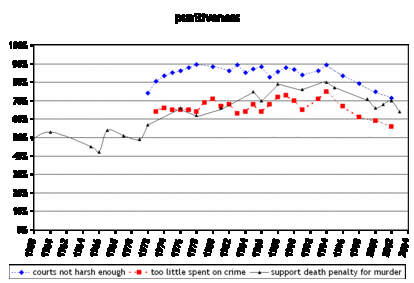 many criminologists and politicians believe that the public is more punitive today than ever before, but that's not quite true. the chart below shows responses to three standard punitiveness indicators: the perception that courts are not harsh enough, that too little money is spent combating crime, and support for the death penalty. all peaked in 1994 but have declined significantly since then.
many criminologists and politicians believe that the public is more punitive today than ever before, but that's not quite true. the chart below shows responses to three standard punitiveness indicators: the perception that courts are not harsh enough, that too little money is spent combating crime, and support for the death penalty. all peaked in 1994 but have declined significantly since then. 
so maybe times are changing. people seem to feel less afraid of street crime in their everyday lives today than they did a decade ago, as both police and victimization data suggest they should. although a majority still favor "tougher" crime policy, the percentage has declined significantly over the past decade. i read these trends as providing an opening for reintegrative efforts. more people seem ready to view law violators as fallible human beings who will eventually desist from crime rather than as irredeemable monsters. if so, it creates a policy opportunity to reorient correctional practices toward the clear-headed goal of maximizing public safety.
Thursday, October 20, 2005
crime, fear, and public opinion
some comments on the last post raised the issue of fear of crime and the ucr crime rate. here are a few figures i've been playing with to track these trends. first, compare the general social survey fear of crime indicator with the ucr index offense rate and the percentgage believing that crime is the most important problem. according to the gss, the percentage of people afraid to walk in their own neighborhoods dropped from about 45 percent in 1994 to 30 percent in 2001. 1994 was the year of bill clinton's crime bill debates, so you see a big spike in the percentage naming crime as the most important problem facing the nation.
Subscribe to:
Post Comments (Atom)

No comments:
Post a Comment